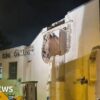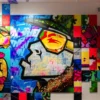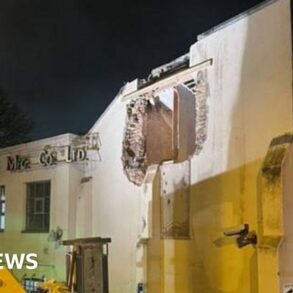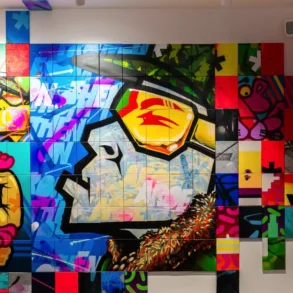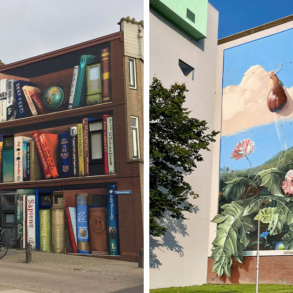SINGAPORE – Singapore’s urban art scene has gone from vandalism to art with street cred in three decades.
At mural hot spots Kampong Glam, Chinatown and Little India, visitors wonder how this edgy art form with roots in defiance is thriving in a city known for being orderly.
While there are severe deterrents for vandalism – such as a fine and jail term if one damages public or private property – there are also specially allocated “concrete canvases” across the island for freedom of artistic expression.
“Graffiti” and “street art” have now become subsumed under “urban art”, says Mohammed Zulkarnaen Othman, 45, a pioneer of the local mural scene who goes by the moniker Zero 45.
He says this is because of the evolving roles of visual artists and the spirit of mutual trust that has been nurtured between artists and the Government, especially in the last decade.
The National Arts Council (NAC) has also been collaborating with artists, venue owners and public agencies to enliven the street art scene in Singapore.
It has supported art projects, including murals and installations, through initiatives such as Singapore Art Week, public art commissions in parks, and collaborations with the Land Transport Authority for art on trains and viaducts.
“For Singapore to be a distinctive city for the arts, the collective effort of everyone is required – from private organisations to public agencies to our arts community,” says Mr Tay Tong, director of NAC’s Arts Ecosystem Group (Visual Arts).
“With venue owners partnering artists to bring the arts everywhere, and artists exploring more cross-sector collaborations, we envision the island becoming a distinctive city that inspires the spirit of innovation and creativity.”
Since the mid-1990s in Singapore, spray-painted graffiti has given way to paintbrushes through greater collaboration between building owners, artists and government authorities, resulting in works that engage the public through visual storytelling.
Early urban art collectives such as OAC in the mid-1990s; ZincNiteCrew, which was founded in 1998 by SlacSatu; and RSCLS, which Zero co-founded in 2009, helped to push the message that art in public places can dispel misconceptions that a pedestrian outing here is sterile.
Around this time, urban art was already on an upward trajectory in the region.
In Australia, the city of Melbourne flaunted “graffiti lanes” with the largest street art enclaves in Caledonian Lane –birthplace of the Laneway Festival of music – and Hosier Lane that constantly changed.
Over in old George Town in Penang, Malaysia, tourist arrivals spiked in 2012 after Lithuanian artist Ernest Zacharevic transformed bare walls in the Unesco Heritage Site into massive canvases, as part of the annual George Town Festival.
And in June 2024, an unsanctioned mural by Singapore-based American artist Sean Dunston on the facade of a conserved building in South Bridge Road, depicting a young samsui woman taking a cigarette break, sparked debate nationwide.
“People were focused on how the samsui woman was portrayed, but failed to see that the image was of a migrant labourer from our collective past who helped build Singapore,” says Zero, who is a part-time lecturer at Lasalle College of the Arts.
“Public art is powerful. It can be used to shape minds and propagate identity, history and heritage. But does this have to be a top-down approach where we see only sanctioned murals that are aesthetically pleasing commissioned by government agencies or commercial entities?”
He adds: “We have to also think about how much of urban art in our public spaces today is a reductive view of our history, heritage and shared experiences.”
For urban art to evolve and for the city-state to grow as a cultural and artistic hub, society has to go beyond aesthetics to explore nuances of Singapore life that not only make people stop and stare, but also think.
Urban art plays a vital role in creating a vibrant street life, says Singapore University of Technology and Design’s Professor Khoo Peng Beng, Head of Pillar at the School of Architecture and Sustainable Design.
He says architecture students at SUTD are taught the importance of designing cities that are not only functional and efficient but also engaging.
By incorporating street art into Singapore’s urban landscape, public spaces can be transformed into dynamic and engaging environments that foster community interaction and social connection.
“Urban art has the power to humanise cities, adding character and personality to otherwise mundane spaces,” says Prof Khoo, who co-founded local architectural practice Arc Studio with his wife Belinda Huang in 1999.
He says embracing this art form can lead to the creation of unique Singapore streetscapes.
“As more opportunities for this form of expression are created, we can become more authentic, expressive and experimental, pushing the boundaries of this form of urban expression to uplift and inspire society.”
The Straits Times talks to four urban artists in Singapore and showcases some of their works.
TraseOne
Sufian Hamri, best known in urban art circles as TraseOne, believes in creating thought-provoking murals that bring people together, rather than provocative or divisive graffiti.
Since starting out in 1999, the 44-year-old has spent more than 20 years honing a style of urban art which he calls “productive social activism”.
This can be seen in his artwork at Mei Ling Market and Food Centre, which was a collaboration in 2022 with Tanjong Pagar Town Council and Queenstown Community Centre.
He created seven murals using a mix of stencils, spray paint, acrylics and bright colours to depict stylised vegetables and children at play. The bold imagery instantly transformed the bare concrete walls of the Housing Board neighbourhood hub.
He is in preliminary talks for a similar project in another HDB estate.
Urban artist Sufian Hamri, also known as TraseOne, with one of his seven murals at Mei Ling Market and Food Centre.ST PHOTO: MARK CHEONG
Today, he is part of the RSCLS art collective and works with its crew of urban artists on mural projects across the island.
His latest work was with the Light To Night Singapore 2025 festival in the Civic District, where he led a team of urban artists for the Now You See Us? light projection segment at The Arts House. It transformed the building’s historic facade into a canvas with a riot of colour.
Now You See Us? delved into the main idea behind graffiti: its visibility.
A marquee event of Singapore Art Week, held from Jan 17 to Feb 6, the multimedia show traced the evolution of Singapore’s graffiti scene, from its underground roots to mainstream acceptance and its potential for the future.
TraseOne worked with Singapore-based audiovisual specialists Metamo Industries to create a fusion of intricate visuals with an accompanying soundscape composed by local music duo O$P$ (Owe Money Pay Money).
He also worked with nine other artists, including Zero 45 and Antz (Anthony Chong).
TraseOne led a team of artists for the Now You See Us? projection at The Arts House for Light To Night Singapore 2025.PHOTO: LIANHE ZAOBAO
“This was the most interesting project for me so far, as projection mapping was something I had never done before,” says TraseOne, who is married with two children.
Infusing visual technology into his work was key in the age of artificial intelligence (AI), he says, as he wanted the art to come alive instead of staying static.
“It’s not about covering physical areas with a spray can or brush, but a measurement of my capabilities and seeing what else I can do with my art.”
He says urban art is a great way to communicate with the community at large.
Street artist Sufian Hamri (TraseOne) at one of seven murals done with local residents at Mei Ling Market and Food Centre.ST PHOTO: MARK CHEONG
“Compared with art locked up in galleries where the viewer has to pay an entry fee to view the works, murals and urban art are out there in the open, free for everyone to appreciate,” he says.
As a practising artist in Singapore, he knows there is a limit to what he can express in his works, but appreciates the opportunities he and his fellow artists have been given.
“It’s about working with the system, and using it to one’s advantage. The public art scene is constantly evolving, now more than ever with AI and more immersive ways to tell stories on blank canvases made of concrete.”
Zero 45
Zero 45 – whose real name is Mohammed Zulkarnaen Othman – is a pioneer of street art in Singapore.
In December, he worked with East Coast residents and committee organisers at Bedok Stadium on a community artwork called Illuminate 2025, which allowed people from all walks of life to contribute despite not being trained in art.
A 2022 photo of street artists Mohammed Zulkarnaen Othman (right), also known as Zero, and Laurie Maravilla (left) with their work for the Singtel Waterfront Theatre. PHOTO: ST FILE
In the early 2000s, the Nanyang Academy of Fine Arts (Nafa) graduate left corporate life as a graphic designer to strike out on his own.
He founded his first street art collective, ARTVSTS, with five Nafa schoolmates in 2003 and his second, RSCLS (pronounced “rascals”), in 2009 with fellow artists Antz and Clogtwo.
RSCLS, which has been at Aliwal Arts Centre since 2013, counts 13 artists from Singapore and Asia as members.
In 2017, Zero graduated at the top of his cohort in Lasalle College of the Arts with a master’s in fine arts.
Making a living through mural commissions and residencies in schools, he focuses on creating spaces and programmes to support the urban art community.
He has curated numerous exhibitions both locally and internationally, produced the visual arts component for the Aliwal Urban Arts Festival since its inception in 2014 and mentored many young artists.
In 2013, he became the first street artist in Singapore to be awarded the National Arts Council’s Young Artist Award.
His works from a 2010 solo show at The Substation, called The Spectacular Spectacular, have been acquired by the Singapore Art Museum and are now part of its permanent collection.
For the last two decades, Zero, 45, has also been conducting research into graffiti, street art and urban art in Singapore and the region.
“I have always looked at my artistic practice as an extension of my experience and space, as a person living in contemporary times,” says Zero.
He uses bold colours as an initial point of attraction to draw viewers nearer to the artwork, where they can then get a better look at his reflections and expressions.
“I paint stylised portraits and faces which reflect the fatigue that sets in when one lives in a fast-paced society,” he says.
These can be seen in his full-height murals around the city, such as in Joo Chiat, Telok Blangah and the RSCLS permanent installation at the Esplanade’s Singtel Waterfront Theatre.
His works can also be seen at the new Punggol Coast MRT Station.
A 2017 photo of Zero with his Hindoo Road mural of Indian actor Rajinikanth.PHOTO: BERITA HARIAN FILE
One of his favourite pieces is a 2016 portrait of South Indian veteran actor Rajinikanth, which Zero titled Working Class Hero, as a parallel to Singapore’s samsui women.
It was painted as a homage to the migrant South Asian labourers who have helped shape and build “almost every modern landmark” in Singapore.
Another mural in Joo Chiat – called Dekat Di Mata, Jauh Di Hati (Malay for “in plain sight, but far from the heart”) – touches on the loss of memories and spaces, either through gentrification, modernisation or time.
Zero 45’s mural, titled Dekat Di Mata, Jauh Di Hati, at 290A Joo Chiat Road.PHOTO: LASALLE COLLEGE OF THE ARTS
He feels that the past is something that should not be seen only through rose-tinted glasses, but as lessons to help people transition into the future.
Through his works, Zero hopes to spark more discussions about taking a more critical approach to urban art.
“Though murals are everywhere now, can we truly categorise them as street art? Take public sculptures, such as those by (Singaporean artists) Han Sai Por and Kumari Nahappan. Do these come under street art too?” he posits.
As an educator and artist, Zero says these issues are close to his heart and existence.
“I hardly want to label myself as a street artist or graffiti artist, as the nature of the craft is far removed from its true nature in Singapore,” he says.
“The complexities of graffiti and street art include social commentaries, cultural norms, practices and ensuring that one’s voice is heard in Singapore.”
Yip Yew Chong
Singaporean visual artist Yip Yew Chong’s larger-than-life murals on the facades of buildings are not strictly “street art”, he is quick to point out.
“Street art is technically different,” the 56-year-old tells The Straits Times. In 2025, he marks a decade since painting his first street mural.
Yip lives in Tanjong Pagar with his family, travelling regularly to his art studio in Pearl’s Hill, Chinatown, where he works on art commissions and dabbles in the exploratory and experimental.
“My works are street murals, public art or urban art,” he adds.
A 2023 photo of artist Yip Yew Chong with his 60m-long painting of old Singapore, which took him 1½ years to complete.PHOTO: ST FILE
Yip has amassed a sizeable body of varied works, including a 60m-long canvas painting in 2023 depicting daily life in Singapore when he was growing up in the 1970s and 1980s.
But he says his murals in Chinatown, Little India and Kampong Glam are the most visible.
The artist started painting street murals in 2015 while holding down a day job as a finance director at a British multinational firm based in Singapore.
Artist Yip Yew Chong’s 2023 mural, titled tHIs is our STORY, showcases the history of Singapore’s Hindustani community.PHOTO: YIP YEW CHONG
He switched to pursuing art full time in mid-2018.
“My art style is semi-realistic storytelling and reflects the site’s daily life,” says Yip.
“I love travelling and have a passion for a place’s culture and daily life, be it in Singapore or overseas. I strive to create visuals and stories that the local community is able to relate to easily.”
He says most of his clients who commission art for their properties request for his particular visual style.
“I do get bored with requests for heritage and nostalgic scenes, especially of similar places, settings and stories. I believe my audience will get bored too.”
For now, he has hit the pause button on murals in Singapore “so as not to overdo it”, and is focusing on canvas paintings and murals in other cities.
Singapore artist Yip Yew Chong painted this mural of daily life and street food in Coimbatore in Tamil Nadu, India, in 2024.PHOTO: YIP YEW CHONG
In January 2024, he created a 15m by 14m mural in the South Indian city of Coimbatore, Tamil Nadu.
It showed images of daily life, such as a drinks seller pouring teh tarik and a woman serving thosai, a pancake made from a fermented batter of ground rice and black gram.
Then in October 2024, he completed a street mural in Wuhan, China, depicting quays along the Yangtze River in the 1920s.
“The team in China conducted thorough research and provided technical logistics support, which allowed me to finish the murals in 10 days,” he says.
Yip feels that the urban art scene in Singapore is on an upward trajectory and has become more diverse in styles, formats, themes and locations.
Singapore artist Yip Yew Chong with his 2024 mural in Wuhan, China, which depicts the quays along the Yangtze and Han Rivers in the 1920s. PHOTO: COURTESY OF YIP YEW CHONG
He says the general public, private sector and government organisations have also learnt to better appreciate urban art over the past decade.
“However, there is still a lingering air of control and preferences towards what institutions deem as ‘good’ art,” he says.
“If it is more relaxed, the diversity will allow artists and their sponsors to push boundaries and make the art scene here even more vibrant and dynamic.”
Antz
Painting on walls and public spaces is an exhilarating experience for urban artist Anthony Chong, also known as Antz.
“One of the most rewarding challenges of urban art is witnessing real-time reactions from passers-by and observing their interactions with my work as I am painting,” says the 42-year-old, an urban art pioneer in Singapore who has been practising for the last 19 years.
Singapore urban artist Anthony Chong, also known as Antz, with his mural in Orchard Road’s Somerset Belt.PHOTO: ZANE
He is best known for art that incorporates Chinese phrases and imagery, such as the visual symbolism of the mythical Monkey King or Sun Wukong from the 16th-century Chinese literature classic, Journey To The West.
After completing his diploma in 2002 in digital media design, with a specialisation in two-dimensional animation and graphic design, from Nanyang Polytechnic, he co-founded urban art collective RSCLS in 2009 with fellow artists Zero 45 and Clogtwo.
Anthony Chong’s (Antz) mural at Stamford Arts Centre. PHOTO: ANTZ
He says the urban art scene has flourished in the last decade, with growing public appreciation and acceptance for the art form from the authorities, residents and tourists.
Many urban festivals today incorporate public art and live painting, so audiences can see the creative process unfold.
Today, Antz and the artists at RSCLS work closely with government agencies like the National Arts Council, which oversees most of the art in public spaces, and the Urban Redevelopment Authority, which evaluates urban art proposals for the facades of conserved buildings.
RSCLS regularly conducts talks, live painting events and workshops in schools in Singapore and overseas.
Antz says public debate is healthy for the art form to flourish and evolve.
Anthony Chong’s (Antz) back-alley mural in Kampong Java.PHOTO: ANTZ
“One of the most intriguing public reactions was to the samsui woman mural, where people not only engaged with the artwork, but also took the time to interpret its message.
“That’s the kind of response I aim to spark. Art is always subjective, and seeing diverse perspectives and discussions unfold is incredibly rewarding. This is how the public learns about the stark differences between vandalism, graffiti, street art and urban art.”
Join ST’s Telegram channel and get the latest breaking news delivered to you.
This post was originally published on this site be sure to check out more of their content.

